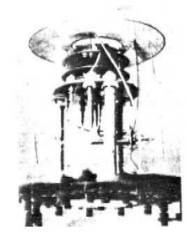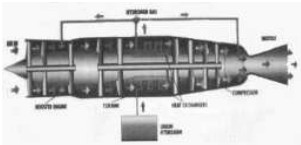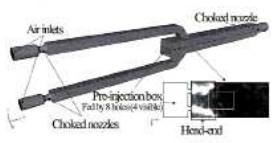Updated: 28-Oct-2020
It is the "Office Nationale d'Etudes et de Recherches Aerospatiales".
-Their study and research were of all kinds and for any branch of the industry. From aerospace we choose as an example an old “ion” engine that used mercury.

“ONERA ion thruster”
-The obtained thrust was 0.2 grams and represents a consumption of 70 micrograms of mercury per second, projected at 51 km/sec (183,600 km/h or 114,084 mph). For space travel, naturally.
In 1949, Maurice Roy, who was the study-center director at the time, presented a very interesting braking system but more complicated and heavy than the current reversals.

“Braking system according to ONERA”
-It was published in number 1414 of "les Ailes" in March 1953.
-On the centrifugal compressor, a divider sends all the air to the main combustion chambers or divides it and a part goes to other front chambers that send the jet forward.
-Sincerely, it does not seem practical and it is not known if it was tested, so we also assume it would not be operational.
-Without a doubt, ONERA carries out much more work and in all fields.
-It also has an Aeronautical School, located in Toulouse.
From Appendix 6: A new engine for speeds as high as Mach 4 and for future Mach 7 appeared from their Labs in the early 1990's.
-It was known as "reverse-cycle" and called Priam. It used liquid hydrogen as fuel.

“Turborreactor Priam”
-No detailed information on its operation is available.
-We see that it contains turbines and compressors, and liquid hydrogen is used twice: to cool the intake air and as fuel.
-To reach the necessary initial speeds, it is launched by means of a booster engine -not shown-.
From Appendix 9: This is the National Office for Aerospace Studies and Research.
-The projects were materialized by the SEPR-SEP. The rocket engines to be introduced in this publication can be:
-SEPR-685-4
-SEPR-734-1
-SEPR-737
-SEPR-739-2
-SEPR-740-3
-Neptune
-This French aeronautical and space study and research center has recently carried out tests with a generation of ramjets with a totally different and unusual design.

“ONERA ramjet schematic”
-It is a "Research ramjet" that has two air intake ducts in it -which would actually be four-, and that affect the combustion chamber a little earlier. The injector that is mentioned with four holes would actually have eight. There are no known flight tests.
From Appendix 12: The Office Nationale d’Etudes et Recherches Aerospatiels continues to operate at the former facilities in Chalais-Meudon.
During my last visit to the MAE, in the engine reserve storage (in the Bermuda hangar), I saw an experimental engine or ramjet for naval missiles, the old prototype of the “Scorpion Project”, a ramjet with four cruciform air intakes.

"ONERA Scorpion Project"
Engines of ONERA
Model: ATRE, electricos
Arquitecture:
Chambers:
Fuels:
Feed System:
Ignition:
Thrust:
Weight:
Model: Motores experimentales. (Nova, etc)
Arquitecture:
Chambers:
Fuels:
Feed System:
Ignition:
Thrust:
Weight:
Model: Neptune
Arquitecture:
Chambers:
Fuels:
Feed System:
Ignition:
Thrust:
Weight:
Model: SEPR 685-4,
Arquitecture:
Chambers:
Fuels:
Feed System:
Ignition:
Thrust:
Weight:
Model: SEPR 734-1
Arquitecture:
Chambers:
Fuels:
Feed System:
Ignition:
Thrust:
Weight:
Model: SEPR 737
Arquitecture:
Chambers:
Fuels:
Feed System:
Ignition:
Thrust:
Weight:
Model: SEPR 739-2
Arquitecture:
Chambers:
Fuels:
Feed System:
Ignition:
Thrust:
Weight:
Model: SEPR 740-3
Arquitecture:
Chambers:
Fuels:
Feed System:
Ignition:
Thrust:
Weight:


